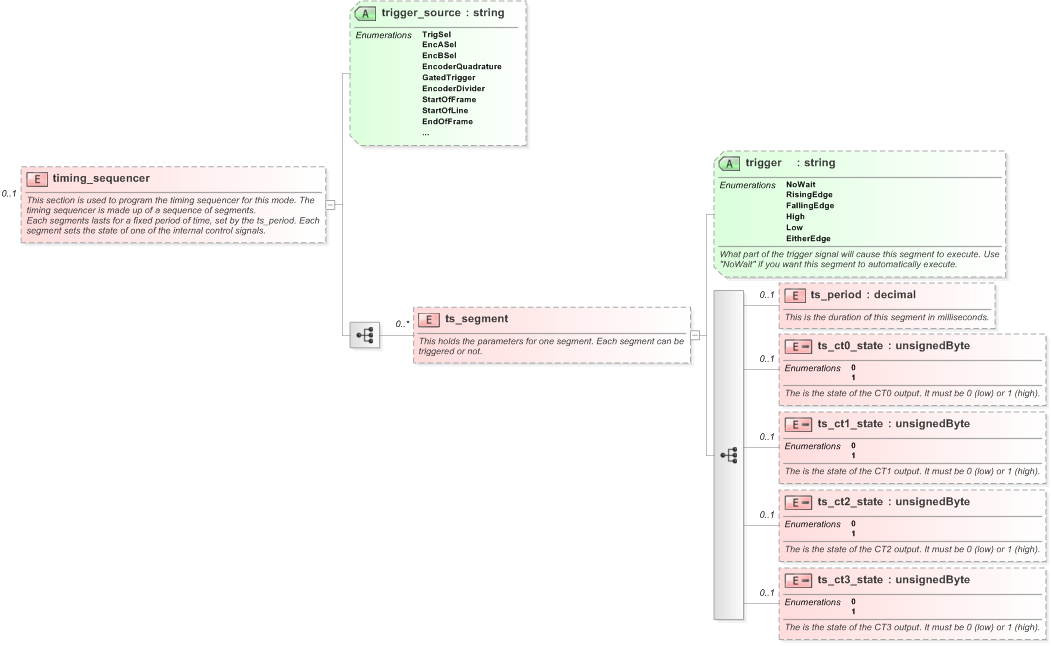<xs:element name="timing_sequencer" minOccurs="0">
<xs:annotation>
<xs:documentation>This section is used to program the timing sequencer for this mode. The timing sequencer is made up of a sequence of segments.
Each segments lasts for a fixed period of time, set by the ts_period. Each segment sets the state of one of the internal control signals.</xs:documentation>
</xs:annotation>
<xs:complexType>
<xs:sequence>
<xs:element name="ts_segment" minOccurs="0" maxOccurs="unbounded">
<xs:annotation>
<xs:documentation>This holds the parameters for one segment. Each segment can be triggered or not.</xs:documentation>
</xs:annotation>
<xs:complexType>
<xs:sequence>
<xs:element name="ts_period" type="xs:decimal" minOccurs="0">
<xs:annotation>
<xs:documentation>This is the duration of this segment in milliseconds.</xs:documentation>
</xs:annotation>
</xs:element>
<xs:element name="ts_ct0_state" minOccurs="0">
<xs:annotation>
<xs:documentation>The is the state of the CT0 output. It must be 0 (low) or 1 (high). </xs:documentation>
</xs:annotation>
<xs:simpleType>
<xs:restriction base="xs:unsignedByte">
<xs:enumeration value="0" />
<xs:enumeration value="1" />
</xs:restriction>
</xs:simpleType>
</xs:element>
<xs:element name="ts_ct1_state" minOccurs="0">
<xs:annotation>
<xs:documentation>The is the state of the CT1 output. It must be 0 (low) or 1 (high). </xs:documentation>
</xs:annotation>
<xs:simpleType>
<xs:restriction base="xs:unsignedByte">
<xs:enumeration value="0" />
<xs:enumeration value="1" />
</xs:restriction>
</xs:simpleType>
</xs:element>
<xs:element name="ts_ct2_state" minOccurs="0">
<xs:annotation>
<xs:documentation>The is the state of the CT2 output. It must be 0 (low) or 1 (high). </xs:documentation>
</xs:annotation>
<xs:simpleType>
<xs:restriction base="xs:unsignedByte">
<xs:enumeration value="0" />
<xs:enumeration value="1" />
</xs:restriction>
</xs:simpleType>
</xs:element>
<xs:element name="ts_ct3_state" minOccurs="0">
<xs:annotation>
<xs:documentation>The is the state of the CT3 output. It must be 0 (low) or 1 (high). </xs:documentation>
</xs:annotation>
<xs:simpleType>
<xs:restriction base="xs:unsignedByte">
<xs:enumeration value="0" />
<xs:enumeration value="1" />
</xs:restriction>
</xs:simpleType>
</xs:element>
</xs:sequence>
<xs:attribute name="trigger" use="optional">
<xs:annotation>
<xs:documentation>What part of the trigger signal will cause this segment to execute. Use "NoWait" if you want this segment to automatically execute.</xs:documentation>
</xs:annotation>
<xs:simpleType>
<xs:restriction base="xs:string">
<xs:enumeration value="NoWait" />
<xs:enumeration value="RisingEdge" />
<xs:enumeration value="FallingEdge" />
<xs:enumeration value="High" />
<xs:enumeration value="Low" />
<xs:enumeration value="EitherEdge" />
</xs:restriction>
</xs:simpleType>
</xs:attribute>
</xs:complexType>
</xs:element>
</xs:sequence>
<xs:attribute name="trigger_source" use="optional">
<xs:annotation>
<xs:appinfo>order:0</xs:appinfo>
</xs:annotation>
<xs:simpleType>
<xs:restriction base="xs:string">
<xs:enumeration value="TrigSel" />
<xs:enumeration value="EncASel" />
<xs:enumeration value="EncBSel" />
<xs:enumeration value="EncoderQuadrature" />
<xs:enumeration value="GatedTrigger" />
<xs:enumeration value="EncoderDivider" />
<xs:enumeration value="StartOfFrame" />
<xs:enumeration value="StartOfLine" />
<xs:enumeration value="EndOfFrame" />
<xs:enumeration value="EndOfLine" />
</xs:restriction>
</xs:simpleType>
</xs:attribute>
</xs:complexType>
</xs:element>
|

